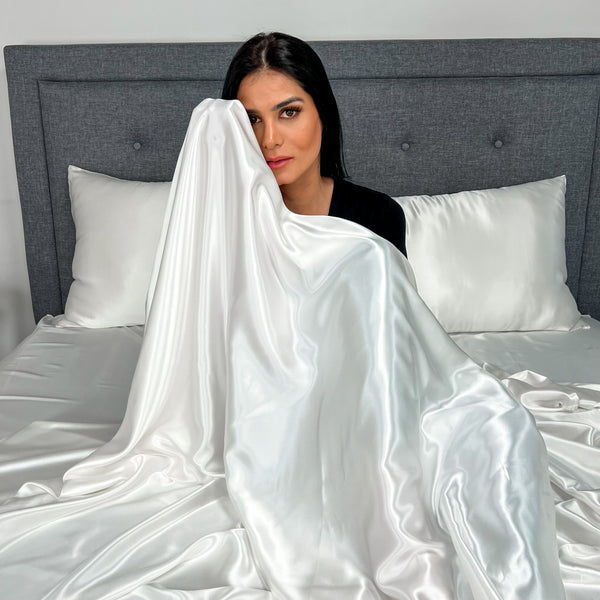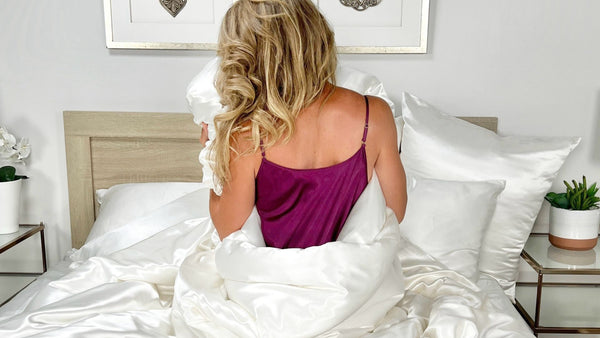The term "vegan silk" is inherently confusing. Is vegan silk real? By definition, genuine silk is made with animal byproducts and therefore can't be vegan. So, what is vegan silk? Mulberry Park Silks has answers about so-called vegan silk and other types of artificial silk.
Inside this Article:
Real Silk: A Fabric Like No Other

Silk has been a sought-after luxury fabric for centuries, prized for its softness, luster, and durability as well as its unique beauty and wellness benefits. Part of what makes genuine silk fabric so special is its origins: real silk is made from the protective, hypoallergenic cocoon of farm-raised silkworms. Mulberry silk-the only type we sell at Mulberry Park Silks-is made from the cocoons of silkworms that are fed an exclusive diet of mulberry leaves. Traditional silk production (known as "sericulture") is an agricultural discipline that has been practiced for thousands of years, originating in China and later spreading to Europe and North America.
Vegan Silk: A Confusing Term

In recent years, silkworm farming has come under increased scrutiny. This has led to some confusing terminology, including the use of the term "vegan." (Note: There is a type of silk produced after the silkworm naturally sheds its cocoon; this humanely farmed silk is known as "Ahimsa" or "peace silk" and it is genuine silk. However, Ahimsa silk is not vegan, as it is made from silkworm cocoons.) "Vegan silk" has also been used to describe other fabrics that emulate the look and feel of silk without any animal products. But is vegan silk genuine? And how does it compare to real silk? This blog will help demystify the topic of vegan silk; identify the various textiles the term is used to describe; and highlight the differences between vegan and genuine silk.
Is Vegan Silk Real?

The short answer is, no, vegan silk is not "real." Only fibers harvested from the cocoon of a silkworm can be considered genuine (other insects do produce silk-like fibers but these are not used for textiles). Despite its name, vegan silk is not actually silk at all. Instead, the term is used to describe a variety of plant-based fabrics that mimic the appearance and texture of silk. Some common types of vegan silk include Tencel made from bamboo, banana silk, orange silk, lotus silk, eucalyptus silk, and milkweed silk. These materials are derived from the fibers of their respective plants and are processed to create soft, lustrous fabrics. These plant-based alternatives offer some environmental benefits-including being biodegradable just like genuine silk-but they do not possess the same unique properties as real silk.
What is Satin?
Another material often marketed as "vegan silk" is satin, which is made from petroleum-based fabrics such as polyester or rayon. Here we must clarify something: in textile terms, satin is a type of weave that is smooth on one side with a matte finish on the reverse; by this definition, charmeuse silk is technically a satin weave.

However, satin weave can also be made from man-made fabrics, including the polyester or rayon we mentioned above. Whether it is called "vegan silk," "silky satin," or another term, these textiles are made from synthetic fibers. They are not vegan, and they do not possess the properties that make silk so very special.
"Confusing silk with man-made polyester satin is one of the biggest misconceptions in the luxury textile industry. Unfortunately, that is often a deliberate attempt to deceive consumers into purchasing a lower-quality product," said Helena Hendricks, Associate Brand Manager at Fine Linen and Bath, a leading online luxury linen retailer. "With the growing popularity of silk, it is quite common to see these artificial fabrics marketed as 'silk' or 'silky' to shoppers looking to derive the benefits only real silk can offer."
Genuine silk will always be labeled and will look and feel different from polyester satin. This article offers several other tips for identifying genuine silk when shopping for silk pillowcases and sheets.
Real mulberry silk is a protein-based natural fiber produced from the cocoons of bombyx mori silkworms. The silk fiber is then processed and woven into the luxurious fabric we know as silk. Genuine silk is renowned for its beauty, durability, and superior softness. It retains the hypoallergenic, hydrating, and protective properties of the cocoon. Silk is also breathable; temperature regulating; resistant to mold and dust mites; and biodegradable.

Why Choose Genuine Silk?
The special properties unique to silk offer compelling benefits that make a great case for choosing a genuine silk pillowcase or sheet set over synthetic satin or even "vegan alternatives."
- Hydrating to hair and skin: Just like your hair and skin, silk is protein-based. The proteins and amino acids help your hair and skin retain moisture. The same cannot be said for other fabrics, especially cotton, which is absorbent and actually pulls moisture away from your hair and skin.
- Preventing tangles, frizz, bedhead, and breakage. The soft charmeuse surface of silk is nearly friction-free, which pampers and protects your hair as you sleep. (Polyester satin also feels smooth, but is more slippery in texture; it also feels a bit like plastic on the reverse side).
- Minimizing sleep wrinkles. The gentle surface of silk prevents the compression of the delicate skin around the eyes, thus minimizing sleep wrinkles.
- Non-irritating. Genuine silk is hypoallergenic and resistant to mold, dust, and other allergens, making it ideal for anyone suffering from allergies or with sensitive skin or conditions such as acne, eczema, and psoriasis.
- Temperature regulating: Silk fibers have a unique structure that allows them to wick away moisture and regulate body temperature, keeping you cool in the summer and warm in the winter. This allows you to rest comfortably-and perhaps sleep more soundly-in any weather condition
Lastly, there is the luxurious look, feel, and romance of silk. For centuries, no other fabric has been able to provide the indulgent, superior sleep silk is known for. All Mulberry Park Silks pillowcases, bedding, and accessories are made from 100 percent mulberry silk of the highest grade (6A) in a lustrous charmeuse weave. We offer a range of momme weights-19, 22, and 30-in a palette of designer shades sure to suit your style. Even though silk is hypoallergenic, we've also taken the additional step of certifying Mulberry Park Silks products as STANDARD 100 by OEKO-TEX®, which means they have been independently tested as safe from harmful substances.
What's the Best Alternative to Real Silk?

For those seeking a high-quality vegan alternative to genuine silk, we recommend SDH Legna Classic Bedding. This eco-friendly line of modal bedding combines a smooth, supple feel that is reminiscent of silk with the easy care of cotton. Legna bedding drapes beautifully washes easily, and grows softer over time. The modal fiber used to make Legna Classic bedding is harvested from the wood pulp of beech trees, which are grown in sustainably managed European forests under strict environmental guidelines. SDH Legna Classic bedding is also OEKO-TEX® STANDARD 100 certified as safe from harmful chemicals.
We hope we've clarified some of the misconceptions surrounding "vegan silk." While there are some wonderful plant-based silk alternative products on the market, we recommend avoiding any petroleum-based "silky" fabrics. Even the highest-quality plant-based textiles cannot replicate the unique properties of natural silk, which remains the gold standard in comfort, luxury, beauty, and wellness benefits. As always, the Mulberry Park Silks team is here to answer any questions you have about our products and to help you choose your perfect silk pillowcase or sheet set. Give us a call or drop an email. We would love to hear from you.


























